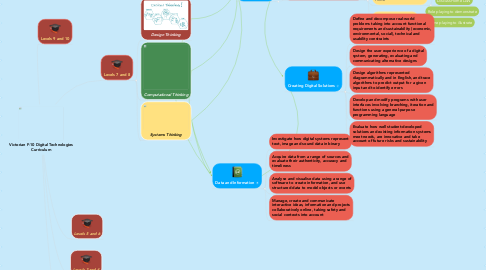Victorian F-10 Digital Technologies Curriculum
저자: Jack Tan

1. Levels 9 and 10
2. Levels 7 and 8
2.1. Design Thinking
2.2. Computational Thinking
2.3. Systems Thinking
3. Levels 5 and 6
4. Levels 3 and 4
5. Foundation - Level 2
6. Digital Systems
6.1. Investigate how data are transmitted and secured in wired, wireless and mobile networks
6.1.1. 1. Networks on the Macro-Level -- How Internet Works
6.1.1.1. To show examples of physical infrastructure
6.1.1.2. To show key concepts through diagrams
6.1.2. 2. Networks on the Micro-Level -- Our School, Home
6.1.2.1. School LAN Tour
6.1.2.2. Discuss Home LAN
6.1.3. 3. Packets Explained
6.1.3.1. Role playing to demonstrate
6.1.3.2. Game playing to illustrate
7. Data and Information
7.1. Investigate how digital systems represent text, image and sound data in binary
7.2. Acquire data from a range of sources and evaluate their authenticity, accuracy and timeliness
7.3. Analyse and visualise data using a range of software to create information, and use structured data to model objects or events
7.4. Manage, create and communicate interactive ideas, information and projects collaboratively online, taking safety and social contexts into account
8. Creating Digital Solutions
8.1. Define and decompose real-world problems taking into account functional requirements and sustainability (economic, environmental, social), technical and usability constraints
8.2. Design the user experience of a digital system, generating, evaluating and communicating alternative designs
8.3. Design algorithms represented diagrammatically and in English, and trace algorithms to predict output for a given input and to identify errors
8.4. Develop and modify programs with user interfaces involving branching, iteration and functions using a general-purpose programming language
8.5. Evaluate how well student-developed solutions and existing information systems meet needs, are innovative and take account of future risks and sustainability



